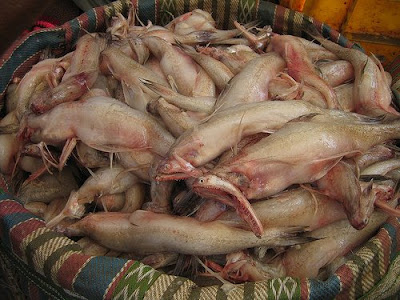Ever heard of Bombay Duck? It isn’t a duck, but a fish; and it isn’t found in Bombay, but pretty much all along the Indian coastline. Then why is it called Bombay Duck? I’ve come across two fairly reasonable arguments for it:
- When the dried fish was transported by the Bombay Mail it became notorious for its smell. Dak being the Hindi word for mail, Bombay Dak (Duck) became the name of the fish.
- Bombay Duck caught on because the native name Bombil or Bamaloh was too hard for the British to pronounce during their Raj.
Bombay Duck is possibly one of the ugliest fish you will ever lay your eyes on. And if you’re like me (I hate cleaning lobsters, which we’ll get into some other day perhaps), when something is a kind of a ‘lizardfish’, you are bound to get the creeps. I was in for a shock when I saw the whole fish a few days ago. Ever since I was a young kid, this was just something I’d see at the dinner table, seasoned with spices and fried to perfection by my grandmum. I’m only happy that I didn’t know so much as a kid and merrily ate whatever was served. Times sure have changed. Today, Bombay Duck is one of my favourite summer snacks – delicate, creamy and full of flavour. So what does it look like?
 Fresh Bombay Duck – It’s worth the sore eyes!
Fresh Bombay Duck – It’s worth the sore eyes!
Fresh Bombay Duck is a very soft fish and is susceptible to spoilage, so most of the catch is sun dried. The photograph you see below is a common sight in fishing villages along the West coast of India where the fish is hung to dry on ropes. A strong, salty, oceany smell follows.
When dried, Bombay Duck can be used as a starter. It is awfully salty, pungent smelling and crisp. It is quite popular at Indian restaurants in Britain served with poppadams. It has a strong, fishy and excessively salty taste with a brittle, crumbly texture. One bite of dried Bombay Duck will have your mouth feel like it is flooded with the ocean salt and then finally, you are reminded of the after taste of strong cheddar cheese. A true gourmet delicacy, dried Bombay Duck can be served lightly dry roasted or fried for a few minutes. A liking for Bombay Duck is an acquired taste, so don’t dismiss it after just having it once!
15 Bombay Ducks
3 tbsp red chilli powder
1 tbsp coriander powder
1 tbsp cumin powder
1 tsp garlic powder
1/2 tsp turmeric
4 tbsp flour
salt
- Wash the cleaned Bombay Ducks thoroughly with salt.
- Dry them on a kitchen towel. We need to have them as dry as possible.
- Mix the dry ingredients together and roll each Bombay Duck in the dry mixture. Let it sit for 10-15 minutes.
- In a non stick pan, heat enough oil for shallow frying.
- Place the Bombay Ducks in the pan so that there is enough room between them, else they will stick to each other. Let it cook on a slow flame.
- Be careful wile turning the fish over – since it is so delicate it will not withstand constant turning – so it’s best to let it cook completely before you turn. It should be completely cooked in 10-12 minutes, depending upon the size of the Bombay Duck.
- Squeeze some lime juice just before it’s served.
Serve hot with some terrific green chutney and voila – fresh, sweet, creamy, fried Bombil ready to eat!

